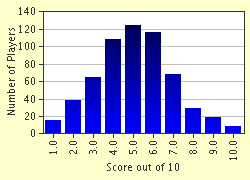Quiz Answer Key and Fun Facts
1. Streptococcus infections can cause all of the following EXCEPT:
2. All of these bacterial diseases are spread by ticks EXCEPT:
3. A PPD skin test is used to diagnose which of the following?
4. All of the following statements about leprosy are true EXCEPT:
5. Which of these statements is true about food-borne botulism?
6. Rocky Mountain Spotted Fever is most common in which state?
7. All of the following statements about endocarditis are true EXCEPT:
8. All of the following statements are true about Legionnaires' Disease EXCEPT:
9. Which of the following statements about bacillary dysentery caused by Shigella is true?
10. All of the following statements about meningitis are true EXCEPT:
Source: Author
alg8r
This quiz was reviewed by FunTrivia editor
crisw before going online.
Any errors found in FunTrivia content are routinely corrected through our feedback system.


